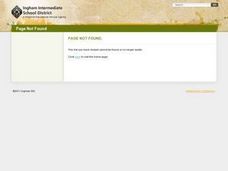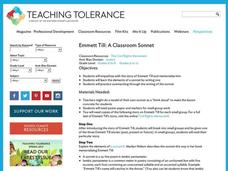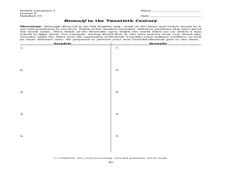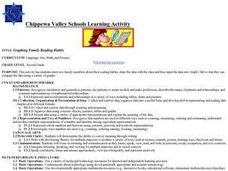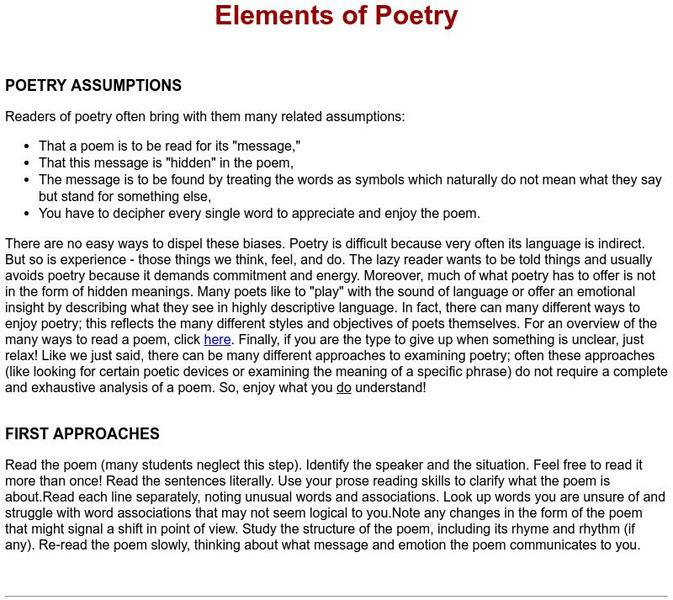Curated OER
Poetry for Kids
Sixth graders be immersed indirect experiences which are opportunities for students to reflect, look back, debrief or abstract from their experiences what they have felt, and thought, and studied.
Brooklyn Children’s Museum
Inside India
What can a Ganesh statue, hand ornament, and print block tell you about India? Introduce your learners to the geography, history, and culture of India by analyzing primary sources and using the well-designed worksheets provided in this...
Curated OER
The Problem with Prejudice
Third graders read and discuss "The Hangman" by Maurice Ogden and answer questions about the poem. They list things they can do to combat prejudice using each of the letters in the word and create a small poster with a slogan against...
Curated OER
I Am a Book
Third graders discuss books that have been banned and the things that they have in common. They explore the concept of freedom of speech and write poems based on their discussion.
Curated OER
Book Report Haiku
Students study another method for writing a book report using a Haiku poem. In this book report lesson, students use the Haiku poem format to write a book report.
Curated OER
Emmett Till: A Classroom Sonnet
Who is Emmet Till? An important historical figure, your kids will be shocked by his story! Discover the details of his life and collaborate to write a crown of sonnets in the style of Marilyn Nelson.
Bully Free Systems
Bully Free Lesson Plans—Seventh Grade
Having a hard time defining bullying with your seventh graders? Discuss the different types of behavior one would see in a bullying situation with a series of lessons, worksheets, and group activities.
Curated OER
Memory of a Kiss
Third graders read, discuss, and memorize the poem "Jenny Kissed Me." as an example of lyrical poetry. They write a letter to Jenny reliving the memory of her kiss from an elderly person's point of view. They illustrate their poems.
Curated OER
Mosaic Pavement Panel
Students analyze Mosaic art and identify the tessellation process. In this Mosaic art lesson, students read information about Mosaic art and the tessellation process. Students compare mosaics from various civilizations and construct...
Curated OER
Symbolism: Finding the Hidden Meaning In Chinese Art
Students study and interpret Chinese art to find its symbolism, or the "hidden meanings" in this middle level lesson well suited for the Language Arts or Art classroom. An enrichment activity is included that allows each student to write...
Curated OER
What is a Cloud?
Third graders identify a cloud and explore how they form. They create an acrostic poem about clouds.
Curated OER
Two Haiku
Eighth graders, in pairs, discuss what they already know about Haiku poetry. They try to remember the rules, history, and focus of traditional Japanese Haiku. they read more examples of Haiku and then write and illustrate their own...
Syracuse City School District
Literary Elements
Address the literary elements in a piece of writing using these materials. The packet includes plenty of resources, and focuses mainly on theme, character, and point of view, with some materials for setting, symbolism, and author's...
EngageNY
Making a Claim: Moon Shadow’s Point of View of the Immediate Aftermath
Body paragraphs are the building blocks of every essay. Pupils view and discuss a model essay using a rubric to evaluate one of its supporting paragraphs. Next, scholars use what they've learned to continue drafting their own literary...
Schools United to Provide Enhanced Resources Network
AP English Project: Journal of Literary Terms and Devices
To prepare for the AP English exams, individuals are asked to create a notebook of literary terms and devices. The terms must be defined, accompanied by representative artwork, and illustrated by an example drawn for a named source. A...
Curated OER
The Concept of the Hero
Students explore the symbolic implications for the concept of the hero with a focus on the Beowulf theme. In this hero concept lesson, students find specific examples of monsters from Beowulf to complete the chart. Students list the...
Curated OER
Silent Stories
Learners create a pictorial narrative based upon John Keats' "Ode on a Grecian Urn" and the Japanese techniques of "lacquer jar" stories in this three-day Language Arts/Art lesson.
Houghton Mifflin Harcourt
Les Miserables Study Help Essay Questions
In this literature worksheet, students respond to 20 short answer and essay questions about Hugo's Les Miserables. Students may also link to an online interactive quiz on the selection at the bottom of the page.
Curated OER
Graphing Family Reading Habits
Second graders collect data from their families about their reading habits and graph them. For this graphing family reading habits lesson, 2nd graders interview family members about their reading habits. They then use a graphing computer...
Curated OER
Build Your Own Adventure
Sixth graders write a narrative. They choose options for plot and climax within the context of an outdoor survival story.
Curated OER
M & M Madness
Second graders graph M & M's by color. In this graphing lesson plan, 2nd graders first predict how many of each color they think are in a handful of M & M's. Then they graph the amounts of each color on a computer program....
ReadWriteThink
Read Write Think: Poetic Form and Structure
This online lesson makes use of concrete poems to teach the structure and form of poetry. Uses a "Columbus Day," theme for the lesson, but can be used any time of the year.
Other
Centre for Literacy in Primary Education: Poetryline: Poetic Forms and Devices
An excellent resource for learning about the different forms and devices used in poetry. Each item is linked to its own page which has examples of its use. Many of the pages have videos of authors reading their poems, and some have...
Other
Lexiconic.net: Elements of Poetry
This resource explains how to approach an analysis of a poem. It discusses assumptions people may have, the importance of reading it closely before analyzing it, looking at the stanza structure, the type of poem, the sound patterns,...


